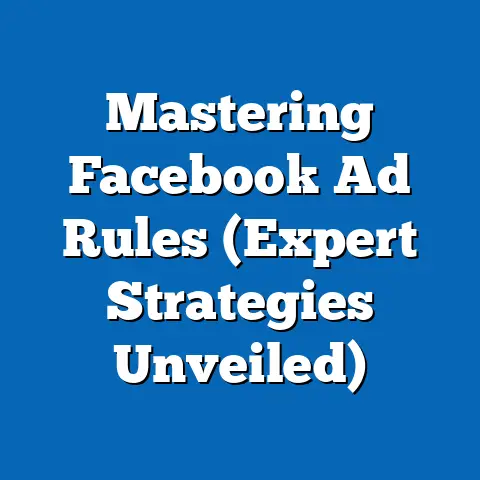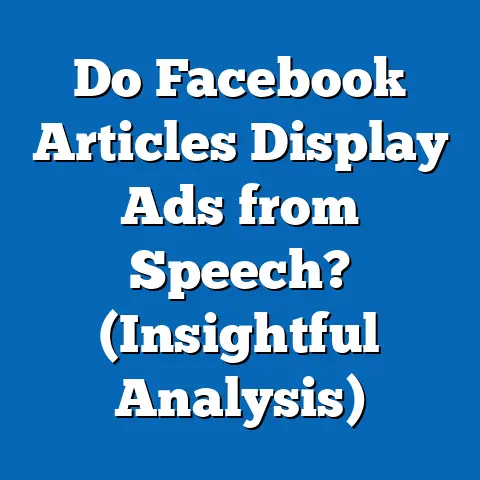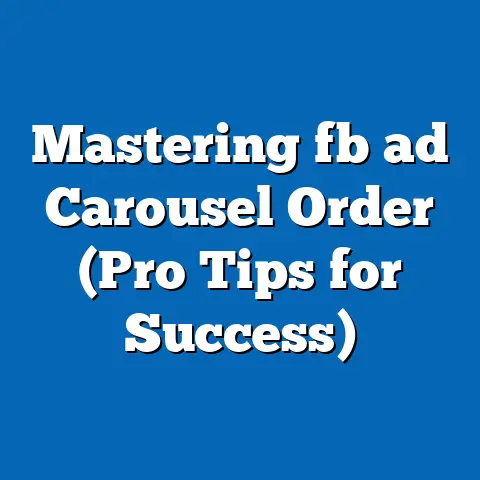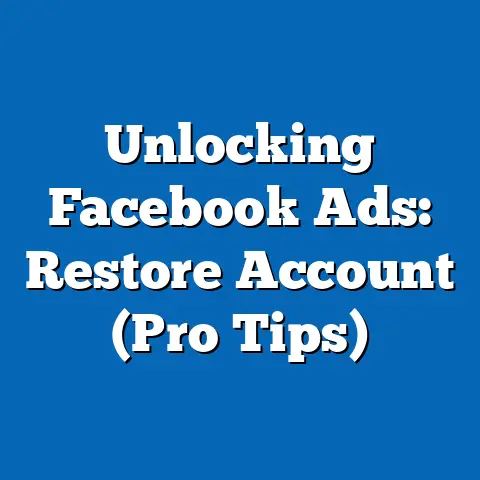Unlocking Competitors’ Facebook Ads (Expert Strategies Revealed)
Imagine walking into a vibrant, modern café. The aroma of freshly brewed coffee fills the air, and the low hum of conversations blends with the clatter of keyboards. But this isn’t just any café; it’s a hub for entrepreneurs and marketers, all laser-focused on their laptops, seeking the next big breakthrough in their digital strategies. In a quiet corner, I sit, sipping a cappuccino, my eyes glued to my laptop screen. I’m not browsing social media or catching up on emails; I’m deep in the trenches, analyzing the Facebook ads of my competitors.
My screen is a kaleidoscope of color, filled with attention-grabbing ad creatives, catchy headlines, and meticulously crafted target demographics. Each ad is a puzzle piece, and I’m determined to fit them together to understand the bigger picture. As I dissect each element, from the persuasive ad copy to the strategically placed call-to-action buttons, I feel a surge of excitement. I’m on the verge of unlocking their secrets, and the thought of leveraging these insights to gain a competitive edge is exhilarating.
This isn’t just a routine analysis; it’s a realization of the power that comes from understanding my competitors’ strategies. It’s about turning their successes and failures into actionable insights that can propel my own campaigns forward. In this article, I’ll delve deep into the art and science of dissecting Facebook ads, exploring techniques that can turn insights into actionable strategies for success. I’ll share my personal experiences, the tools I rely on, and the mindset you need to not just observe, but truly understand what your competitors are doing on Facebook. Let’s get started.
1. Understanding the Facebook Advertising Landscape
Facebook advertising has become a cornerstone of the digital marketing ecosystem. It’s no longer just an option; it’s a necessity for businesses looking to reach a vast and diverse audience. With billions of active users, Facebook provides an unparalleled platform for businesses to connect with potential customers, build brand awareness, and drive sales.
Defining Facebook Advertising
Facebook advertising encompasses the use of paid ads on the Facebook platform, including its associated properties like Instagram, Messenger, and the Audience Network. These ads can take various forms, including images, videos, carousels, and lead generation forms, all designed to capture the attention of users as they scroll through their feeds.
What makes Facebook advertising so powerful is its sophisticated targeting capabilities. Advertisers can target users based on a wide range of criteria, including demographics, interests, behaviors, and connections. This level of granularity allows businesses to reach highly specific audiences, ensuring that their ads are seen by those most likely to be interested in their products or services.
The Evolution of Facebook Ads
Facebook advertising has evolved significantly since its inception. In the early days, ads were simple and less visually appealing. However, as the platform grew and competition increased, Facebook introduced more sophisticated ad formats and targeting options.
One of the biggest shifts was the introduction of the Facebook Pixel, a small piece of code that allows advertisers to track user behavior on their websites. This enabled retargeting, allowing businesses to show ads to users who had previously interacted with their website, increasing the likelihood of conversion.
Today, Facebook advertising is a complex and dynamic landscape, constantly evolving with new features and algorithms. Staying ahead requires continuous learning and adaptation, which is why understanding what your competitors are doing is more important than ever.
The Role of Competitive Analysis
Competitive analysis in Facebook advertising involves systematically examining the ad strategies of your competitors to identify their strengths, weaknesses, and opportunities. It’s about understanding what they’re doing well, where they’re falling short, and how you can capitalize on their mistakes.
By analyzing your competitors’ ads, you can gain valuable insights into their target audiences, messaging strategies, and creative approaches. This information can inform your own ad campaigns, helping you to optimize your targeting, improve your ad creatives, and ultimately, achieve better results.
In my experience, competitive analysis isn’t about copying what your competitors are doing; it’s about learning from them and finding ways to differentiate yourself. It’s about identifying gaps in the market and developing unique strategies that resonate with your target audience.
Takeaway: Facebook advertising is a powerful tool for reaching a vast audience, but it’s also a competitive landscape. Competitive analysis is essential for understanding what your competitors are doing and identifying opportunities to improve your own ad campaigns.
2. The Importance of Competitor Analysis
Why should you spend time and effort analyzing your competitors’ Facebook ads? The answer is simple: it can significantly impact your marketing strategies and ad performance. Understanding what your competitors are doing can help you make more informed decisions, optimize your campaigns, and ultimately, achieve better results.
Informing Marketing Strategies
Competitor analysis provides valuable insights that can inform your overall marketing strategies. By examining your competitors’ ads, you can gain a better understanding of their target audience, their messaging, and their overall brand positioning.
For example, if you notice that several of your competitors are targeting a specific demographic with a particular message, it may indicate that this is a lucrative segment that you should also be targeting. Alternatively, if you see that a competitor is using a certain type of ad creative that is generating a lot of engagement, you may want to consider incorporating similar elements into your own ads.
In one instance, I noticed that a competitor was heavily promoting a specific product feature in their ads. By analyzing their messaging and the comments they were receiving, I realized that this feature was a major selling point for their target audience. I then incorporated this feature into my own ads, highlighting its benefits and addressing any concerns that users had raised in the comments. This resulted in a significant increase in my ad performance and ultimately, more sales.
Improving Ad Performance
Competitor analysis can also help you improve the performance of your Facebook ads. By examining your competitors’ ad creatives, copy, and targeting strategies, you can identify areas where you can improve your own ads.
For example, if you notice that your competitors are using high-quality images and videos in their ads, you may want to invest in better visuals for your own ads. Similarly, if you see that they are using persuasive ad copy that resonates with their target audience, you may want to refine your own messaging to be more compelling.
One of the most valuable things I’ve learned from analyzing competitor ads is the importance of testing different ad variations. By seeing what works for your competitors, you can get a better idea of what might work for you. This can save you time and money by allowing you to focus on the ad variations that are most likely to be successful.
The Impact of Competitor Insights
The impact of competitor insights on ad success can be significant. Studies have shown that businesses that regularly analyze their competitors’ marketing strategies are more likely to achieve better results.
For example, a study by HubSpot found that 61% of marketers who conduct competitor analysis achieve better results than those who don’t. This is because competitor analysis allows you to make more informed decisions, optimize your campaigns, and stay ahead of the competition.
In my own experience, I’ve seen firsthand the impact that competitor insights can have on ad success. By regularly analyzing my competitors’ ads, I’ve been able to identify new opportunities, improve my ad creatives, and optimize my targeting strategies. This has resulted in a significant increase in my ad performance and ultimately, more sales.
Takeaway: Competitor analysis is crucial for businesses looking to improve their marketing strategies and ad performance. By understanding what your competitors are doing, you can make more informed decisions, optimize your campaigns, and achieve better results.
3. Tools and Techniques for Unlocking Competitors’ Facebook Ads
Now that we’ve established the importance of competitor analysis, let’s dive into the tools and techniques you can use to unlock your competitors’ Facebook ads. There are several tools available that can help you analyze competitor ads, each with its own strengths and weaknesses.
AdSpy
AdSpy is one of the most popular tools for analyzing competitor ads. It boasts a massive database of Facebook and Instagram ads, allowing you to search for ads based on keywords, demographics, interests, and other criteria.
One of the key features of AdSpy is its ability to filter ads based on various metrics, such as the number of likes, comments, and shares. This allows you to quickly identify the ads that are performing well and understand why they are resonating with users.
To use AdSpy effectively, start by entering relevant keywords related to your industry or niche. Then, filter the results based on your target audience and other criteria. Pay attention to the ad creatives, copy, and targeting strategies that are being used by your competitors.
In my experience, AdSpy is particularly useful for identifying new trends and emerging opportunities. By regularly monitoring the ads that are being run by your competitors, you can stay ahead of the curve and adapt your own strategies accordingly.
SpyFu
SpyFu is another powerful tool for analyzing competitor ads. While it’s primarily known for its SEO and PPC capabilities, it also offers valuable insights into Facebook advertising.
One of the key features of SpyFu is its ability to identify the keywords that your competitors are targeting in their Facebook ads. This can help you understand their overall marketing strategy and identify opportunities to target similar keywords in your own ads.
To use SpyFu effectively, start by entering the URL of your competitor’s website. Then, navigate to the “Facebook Ads” section to see the ads that they are currently running. Pay attention to the keywords they are targeting, the ad creatives they are using, and the overall messaging of their ads.
I’ve found SpyFu to be particularly useful for identifying competitors that I wasn’t even aware of. By entering relevant keywords, I’ve been able to discover new businesses that are targeting the same audience as me. This has allowed me to expand my competitive analysis and gain a more comprehensive understanding of the market.
SEMrush
SEMrush is a comprehensive marketing toolkit that offers a wide range of features, including competitor analysis for Facebook advertising. It allows you to track your competitors’ ad spend, ad positions, and ad creatives.
One of the key features of SEMrush is its ability to identify the landing pages that your competitors are using in their Facebook ads. This can help you understand their overall marketing funnel and identify opportunities to improve your own landing pages.
To use SEMrush effectively, start by entering the URL of your competitor’s website. Then, navigate to the “Advertising Research” section to see the ads that they are currently running. Pay attention to the landing pages they are using, the keywords they are targeting, and the overall messaging of their ads.
I’ve found SEMrush to be particularly useful for tracking my competitors’ ad spend over time. By monitoring their ad spend, I can get a better idea of their overall marketing budget and identify periods when they are heavily investing in Facebook advertising. This can help me anticipate their moves and adjust my own strategies accordingly.
Analyzing Ad Creatives, Copy, and Targeting
Regardless of the tool you use, it’s important to analyze ad creatives, copy, and targeting strategies. This involves examining the visual elements of the ad, the text that is used to persuade users to take action, and the criteria that are used to target the ad to specific audiences.
When analyzing ad creatives, pay attention to the images, videos, and other visual elements that are used in the ad. Are they high-quality and visually appealing? Do they effectively communicate the message of the ad?
When analyzing ad copy, pay attention to the headlines, descriptions, and call-to-action buttons that are used in the ad. Are they persuasive and compelling? Do they effectively address the needs and concerns of the target audience?
When analyzing targeting strategies, pay attention to the demographics, interests, and behaviors that are used to target the ad to specific audiences. Are they relevant to the product or service being advertised? Do they effectively reach the target audience?
Takeaway: There are several tools available for analyzing competitor ads, each with its own strengths and weaknesses. Regardless of the tool you use, it’s important to analyze ad creatives, copy, and targeting strategies to gain a comprehensive understanding of your competitors’ marketing efforts.
4. Dissecting Competitor Ads: What to Look For
Now that you have the tools and techniques to analyze competitor ads, let’s discuss what to look for when dissecting these ads. Analyzing competitor ads involves examining various elements, including ad copy, visual elements, call-to-action strategies, and target audience demographics.
Ad Copy and Messaging
The ad copy is the text that is used to persuade users to take action. It typically includes a headline, a description, and a call-to-action button. When analyzing ad copy, pay attention to the following:
- Headline: Is the headline attention-grabbing and compelling? Does it effectively communicate the message of the ad?
- Description: Is the description clear and concise? Does it effectively explain the benefits of the product or service being advertised?
- Call-to-action: Is the call-to-action clear and persuasive? Does it encourage users to take the desired action, such as visiting a website or making a purchase?
In my experience, the most effective ad copy is clear, concise, and persuasive. It should clearly communicate the benefits of the product or service being advertised and encourage users to take the desired action.
Visual Elements and Creative Design
The visual elements of an ad include the images, videos, and other visual elements that are used to capture the attention of users. When analyzing visual elements, pay attention to the following:
- Quality: Are the images and videos high-quality and visually appealing?
- Relevance: Are the images and videos relevant to the product or service being advertised?
- Originality: Are the images and videos original and unique? Do they stand out from the competition?
I’ve found that using high-quality and visually appealing images and videos can significantly improve the performance of Facebook ads. It’s important to invest in professional photography or videography to ensure that your ads look their best.
Call-to-Action Strategies
The call-to-action (CTA) is the button or link that encourages users to take a specific action, such as visiting a website, making a purchase, or signing up for a newsletter. When analyzing call-to-action strategies, pay attention to the following:
- Clarity: Is the call-to-action clear and easy to understand?
- Relevance: Is the call-to-action relevant to the product or service being advertised?
- Persuasiveness: Is the call-to-action persuasive and compelling? Does it encourage users to take the desired action?
Some common call-to-action buttons include “Shop Now,” “Learn More,” “Sign Up,” and “Contact Us.” The best call-to-action button will depend on the specific goals of your ad campaign.
Target Audience and Demographics
The target audience is the specific group of people that you are trying to reach with your Facebook ads. When analyzing target audience demographics, pay attention to the following:
- Demographics: What are the age, gender, location, and other demographic characteristics of the target audience?
- Interests: What are the interests and hobbies of the target audience?
- Behaviors: What are the online behaviors of the target audience?
By understanding the demographics, interests, and behaviors of your target audience, you can create more effective Facebook ads that resonate with them.
Interpreting Findings
Once you’ve analyzed the ad copy, visual elements, call-to-action strategies, and target audience demographics of your competitors’ ads, it’s time to interpret your findings. This involves drawing conclusions about what your competitors are doing well, where they are falling short, and how you can capitalize on their mistakes.
For example, if you notice that your competitors are using high-quality images and videos in their ads, but their ad copy is weak and unpersuasive, you may want to focus on improving your own ad copy. Similarly, if you see that your competitors are targeting a broad audience with their ads, you may want to narrow your targeting to reach a more specific group of people.
Takeaway: Dissecting competitor ads involves examining various elements, including ad copy, visual elements, call-to-action strategies, and target audience demographics. By analyzing these elements, you can gain valuable insights into what your competitors are doing well, where they are falling short, and how you can capitalize on their mistakes.
5. Case Studies: Success Stories from Competitor Insights
Let’s explore some case studies of businesses that successfully leveraged competitor ad analysis to improve their own Facebook advertising campaigns. These examples will illustrate how competitor insights can be turned into actionable strategies for success.
Case Study 1: E-commerce Brand Boosting Sales
An e-commerce brand selling handmade jewelry noticed that several of its competitors were heavily promoting their products using video ads featuring customer testimonials. The brand had previously focused on static image ads, but decided to experiment with video ads based on this competitor insight.
The brand created a series of short video ads featuring real customers sharing their experiences with the jewelry. They also incorporated user-generated content from social media, showcasing customers wearing and enjoying the products.
As a result, the brand saw a significant increase in its ad engagement and conversion rates. The video ads resonated with the target audience, who appreciated the authenticity and social proof. The brand’s sales increased by 30% within the first month of launching the video ad campaign.
Key Takeaway: By analyzing competitor ads, the e-commerce brand identified a successful strategy (video ads with customer testimonials) and adapted it to their own marketing efforts. This resulted in increased engagement, higher conversion rates, and a significant boost in sales.
Case Study 2: SaaS Company Refining Targeting
A SaaS company offering project management software noticed that one of its main competitors was targeting a specific industry (e.g., construction) with highly tailored ads. The company had previously used broad targeting, but decided to refine its targeting based on this competitor insight.
The SaaS company created a series of ads specifically tailored to the construction industry, highlighting the features and benefits of its software for project managers in that sector. They also used industry-specific language and imagery in their ad creatives.
As a result, the company saw a significant improvement in its ad relevance score and click-through rate. The refined targeting allowed them to reach a more qualified audience, resulting in a higher conversion rate and lower cost per acquisition.
Key Takeaway: By analyzing competitor ads, the SaaS company identified a more effective targeting strategy (industry-specific ads) and adapted it to their own marketing efforts. This resulted in improved ad relevance, higher click-through rates, and lower acquisition costs.
Case Study 3: Local Business Optimizing Ad Copy
A local restaurant noticed that its competitors were using ad copy that emphasized the quality of their ingredients and the unique dining experience they offered. The restaurant had previously focused on promoting discounts and special offers, but decided to optimize its ad copy based on this competitor insight.
The restaurant created a series of ads that highlighted the fresh, locally sourced ingredients used in its dishes, as well as the cozy and inviting atmosphere of its dining room. They also used mouthwatering images of their most popular menu items.
As a result, the restaurant saw a significant increase in its ad engagement and foot traffic. The optimized ad copy resonated with the target audience, who were drawn to the emphasis on quality and experience. The restaurant’s revenue increased by 20% within the first month of launching the optimized ad campaign.
Key Takeaway: By analyzing competitor ads, the local restaurant identified a more effective messaging strategy (emphasizing quality and experience) and adapted it to its own marketing efforts. This resulted in increased engagement, more foot traffic, and a significant boost in revenue.
Takeaway: These case studies demonstrate the power of competitor analysis in Facebook advertising. By learning from the successes and failures of your competitors, you can make more informed decisions, optimize your campaigns, and achieve better results.
6. Developing Your Own Facebook Ad Strategy Based on Competitor Insights
Now that you’ve learned how to analyze competitor ads and seen examples of how it can lead to success, let’s discuss how to develop your own Facebook ad strategy based on these insights.
Creating a Framework
Start by creating a framework for your Facebook ad strategy. This framework should include the following elements:
- Goals: What are your specific goals for your Facebook ad campaigns? Are you trying to increase brand awareness, drive website traffic, generate leads, or make sales?
- Target Audience: Who are you trying to reach with your Facebook ads? What are their demographics, interests, and behaviors?
- Budget: How much money are you willing to spend on your Facebook ad campaigns?
- Ad Creatives: What types of ad creatives will you use in your Facebook ads? Will you use images, videos, or a combination of both?
- Ad Copy: What type of ad copy will you use in your Facebook ads? Will you focus on the benefits of your product or service, or will you use a more emotional approach?
- Call-to-Action: What type of call-to-action will you use in your Facebook ads? Will you encourage users to visit your website, make a purchase, or sign up for a newsletter?
- Metrics: What metrics will you use to measure the success of your Facebook ad campaigns? Will you track impressions, clicks, conversions, or a combination of these metrics?
Integrating Insights
Once you have a framework in place, it’s time to integrate the insights you’ve gained from analyzing your competitors’ ads. This involves using their successes and failures to inform your own ad targeting, creative development, and budget allocation.
- Ad Targeting: Use competitor insights to refine your ad targeting. If you notice that your competitors are targeting a specific demographic with a particular message, consider targeting that demographic with your own ads.
- Creative Development: Use competitor insights to inform your creative development. If you see that your competitors are using high-quality images and videos in their ads, invest in better visuals for your own ads.
- Budget Allocation: Use competitor insights to allocate your budget more effectively. If you see that your competitors are heavily investing in Facebook advertising, consider increasing your own ad spend to stay competitive.
Monitoring and Adjusting
Once you’ve launched your Facebook ad campaigns, it’s important to monitor their performance and adjust your strategies based on ongoing analysis. This involves tracking your key metrics, such as impressions, clicks, conversions, and cost per acquisition.
If you notice that your ads are not performing as well as you had hoped, don’t be afraid to experiment with different ad variations. Try different headlines, descriptions, images, and targeting strategies to see what works best.
It’s also important to stay up-to-date on the latest trends and best practices in Facebook advertising. The platform is constantly evolving, so it’s important to continuously learn and adapt your strategies accordingly.
Takeaway: Developing your own Facebook ad strategy based on competitor insights involves creating a framework, integrating competitor insights, and monitoring and adjusting your strategies based on ongoing analysis. By following these steps, you can create more effective Facebook ad campaigns that achieve your goals.
7. Ethical Considerations in Competitor Analysis
While analyzing competitor ads can provide valuable insights, it’s important to conduct this analysis ethically and responsibly. There’s a fine line between inspiration and imitation, and it’s crucial to stay on the right side of that line.
Respecting Intellectual Property
One of the most important ethical considerations in competitor analysis is respecting intellectual property. This means avoiding any actions that could infringe on your competitors’ copyrights, trademarks, or other intellectual property rights.
For example, you should never copy your competitors’ ad creatives or ad copy verbatim. This could lead to legal trouble and damage your brand’s reputation. Instead, use your competitors’ ads as inspiration, but create your own original content.
Avoiding Deceptive Practices
It’s also important to avoid deceptive practices when analyzing competitor ads. This means avoiding any actions that could mislead or deceive users, such as creating fake accounts or impersonating your competitors.
For example, you should never create fake Facebook accounts to like or comment on your competitors’ ads. This could be seen as spamming or harassment, and it could damage your brand’s reputation.
Inspiration vs. Imitation
The key to ethical competitor analysis is to focus on inspiration rather than imitation. This means using your competitors’ ads as a starting point, but creating your own unique content that reflects your brand’s values and personality.
For example, if you notice that your competitors are using video ads with customer testimonials, you can create your own video ads with customer testimonials, but make sure that your videos are original and unique.
Takeaway: Ethical competitor analysis involves respecting intellectual property, avoiding deceptive practices, and focusing on inspiration rather than imitation. By following these guidelines, you can analyze competitor ads responsibly and avoid any potential legal or ethical issues.
8. Conclusion: The Future of Facebook Advertising and Competitor Insights
As Facebook advertising continues to evolve, the importance of competitor analysis will only increase. In today’s competitive digital landscape, businesses need to stay ahead of the curve to succeed. And one of the best ways to do that is by understanding what your competitors are doing and learning from their successes and failures.
Continuous Learning and Adaptation
The Facebook advertising platform is constantly changing, with new features, algorithms, and best practices being introduced all the time. To stay ahead of the curve, it’s important to embrace continuous learning and adaptation.
This means staying up-to-date on the latest trends and best practices in Facebook advertising, as well as continuously monitoring your competitors’ ads and adjusting your strategies accordingly.
Embracing Competitor Analysis
Competitor analysis should be a vital component of your marketing strategy. By regularly analyzing your competitors’ ads, you can gain valuable insights into their target audiences, messaging strategies, and creative approaches. This information can inform your own ad campaigns, helping you to optimize your targeting, improve your ad creatives, and ultimately, achieve better results.
Taking the First Step
So, what’s the first step in unlocking your competitors’ Facebook ads? Start by identifying your main competitors and gathering data on their Facebook advertising activities. Use the tools and techniques discussed in this article to analyze their ads and identify their strengths, weaknesses, and opportunities.
Then, use these insights to develop your own Facebook ad strategy, focusing on creating unique and compelling content that resonates with your target audience. Monitor your ad performance closely and adjust your strategies based on ongoing analysis.
By embracing competitor analysis and continuously learning and adapting, you can unlock the full potential of Facebook advertising and achieve your marketing goals.
Takeaway: The future of Facebook advertising will be driven by continuous learning, adaptation, and a deep understanding of competitor insights. Embrace competitor analysis as a vital component of your marketing strategy, and you’ll be well on your way to unlocking the secrets of Facebook advertising success.






